Physical Address
304 North Cardinal St.
Dorchester Center, MA 02124
The phakomatoses are a group of systemic disorders with neurological, ophthalmic and cutaneous manifestations resulting from disorders in cell regulation. No precise definition exists to determine if a condition should be included or not. A common feature is the development of multiorgan hamartomas. A hamartoma is composed of tissue elements normally present in the involved organ or site. The most important of these conditions are neurofibromatosis (see Chapter 69 ), tuberous sclerosis, Sturge–Weber syndrome, and von Hippel–Lindau syndrome. Other conditions sometimes included are Klippel–Trénaunay–Weber syndrome, Wyburn-Mason syndrome, ataxia telangiectasia, diffuse congenital hemangiomatosis, linear nevus sebaceous syndrome, Osler–Weber–-Rendu syndrome and blue rubber bleb nevus syndrome. The genetic, molecular and cellular biology underlying the phakomatoses are increasingly understood; clinical trials with biologic agents have been initiated.
Sturge–Weber syndrome (SWS) is a rare, sporadic, congenital, neurocutaneous syndrome characterized by cutaneous capillary malformations (port wine stain [PWS]) typically involving the forehead, cerebral capillary-venous malformations (leptomeningeal angiomatosis), and glaucoma. It occurs in approximately 1 in 50,000 live births ( Fig. 68.1 ). It is classified into three subtypes: type I – both facial and leptomeningeal angiomas, may have glaucoma (classic SWS, most common); type II – facial angioma alone (no CNS involvement), may have glaucoma; type III – isolated leptomeningeal-brain angioma, usually no glaucoma.
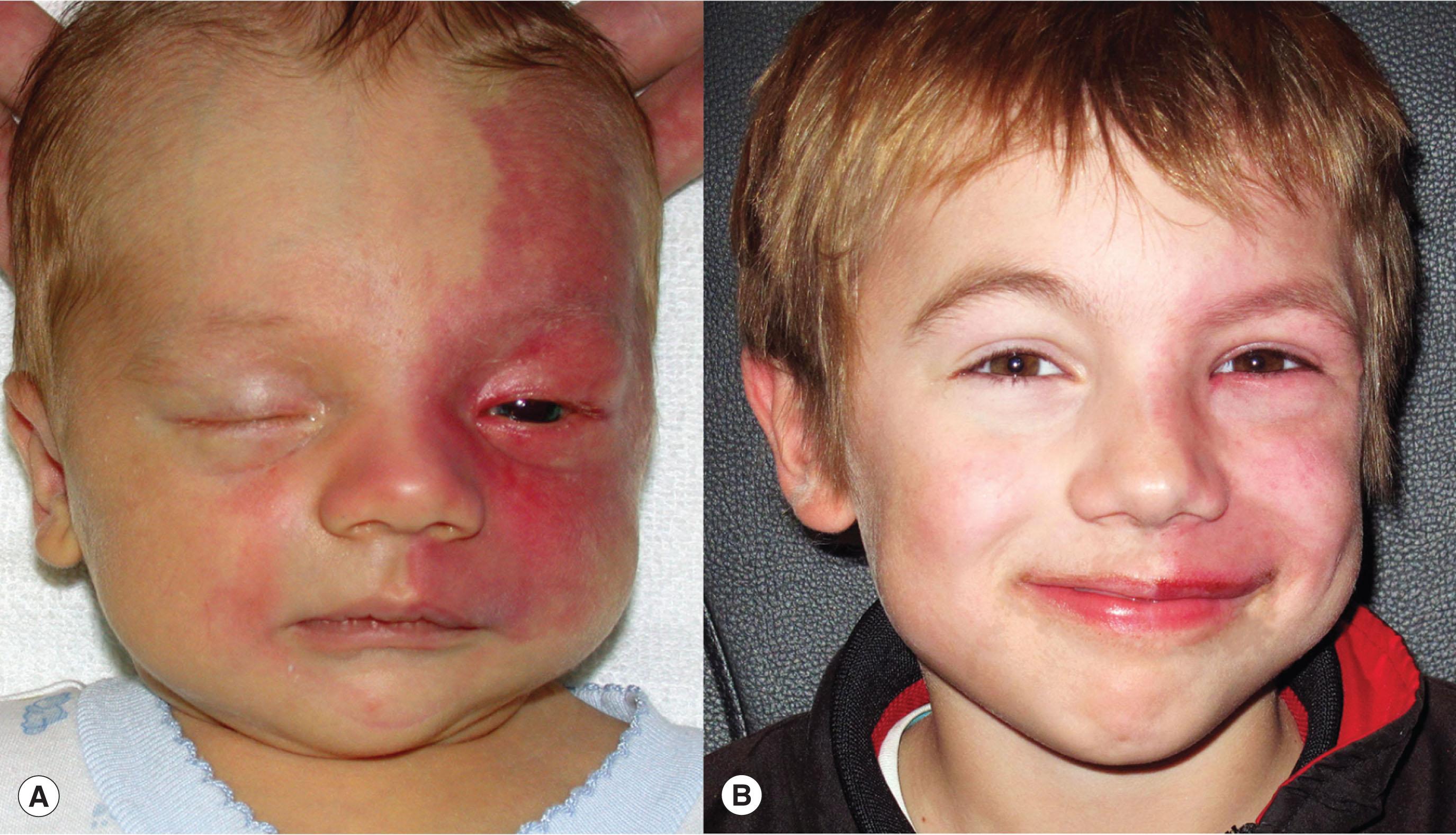
Somatic mosaic activating variants in GNAQ and recently GNA11 have been found associated with both the Sturge–Weber syndrome and non-syndromic port wine stains. GNAQ and GNA11 are highly homologous genes encoding different Gα subunits of the Gαq subfamily of heterotrimeric G-proteins. GNAQ encodes Gαq, which, activates downstream MAPK signaling, including endothelin, which has important roles in vasculogenesis.
The International Society for the Study of Vascular Anomalies provides a classification for vascular birthmarks. These skin lesions are termed “vascular malformations.” In the ophthalmology literature, vascular malformations present in the choroid and conjunctiva have been termed “hemangiomas.” However, the histology shows diffuse choroidal involvement similar to the skin lesions.
Neurological complications are often progressive and include epilepsy, mental retardation, hemiparesis, headache, stroke-like episodes, behavioral problems, and visual field defects. Ipsilateral leptomeningeal vascular malformations are the underlying structural lesions. MRI is recommended for those with forehead PWS involvement ( Fig. 68.2 ). The extent and degree of the neurological symptoms is related to the area and severity of glucose hypometabolism. Seizures are common, and often devastating to the patient and their family, occurring in 75% of unilateral cases and in more than 90% with bilateral involvement. Early seizure onset, high seizure frequency, and bilateral brain involvement have been associated with poor cognitive outcomes, suggesting that seizure control or possibly prevention is critical. A stroke preventative approach to SWS is important, including good hydration during illness, and low-dose aspirin which may reduce the frequency of stroke-like episodes.
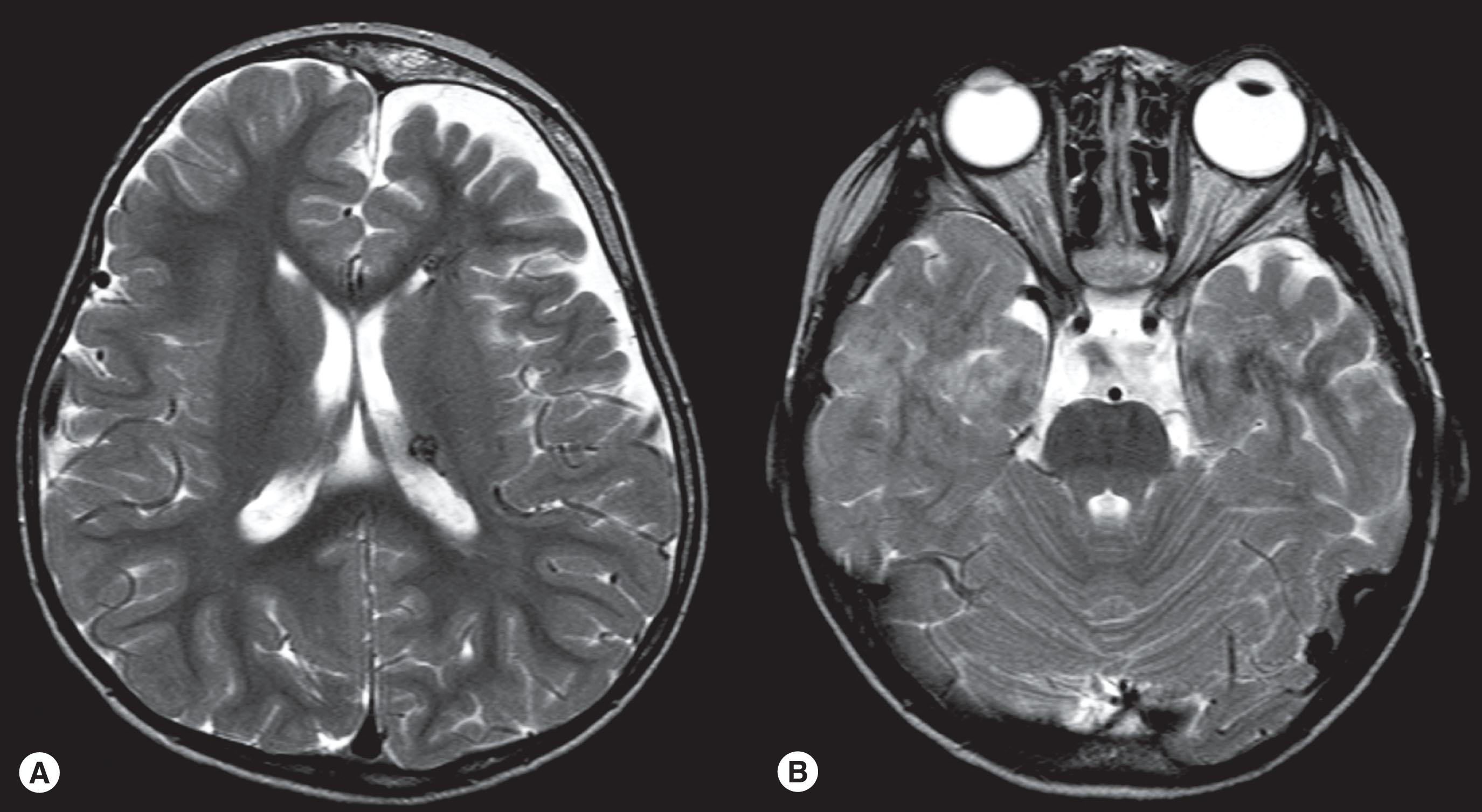
Upper lid skin involvement is commonly associated with intraocular involvement. Glaucoma is the principal ocular complication. It occurs in 58%–71% of cases. There is a bimodal presentation with an early onset group featuring an angle anomaly with trabeculodysgenesis. The late onset glaucoma group is related to raised episcleral venous pressure. The early onset group may later worsen due to increasing episcleral venous pressure.
Choroidal vascular malformations (“hemangiomas”) are common. They may be localized to the posterior pole or extend to the whole fundus. There is loss of the normal choroidal vascular pattern with a diffuse smooth red fundus ( Fig. 68.3 ). Bilateral cases can be difficult to detect. Wide-field imaging with false colorization adds to this difficulty, while wide-field autofluorescence may assist in confirming the locations ( Fig. 68.4 ). Enhanced depth optical coherence tomography (OCT) may assist in determining the extent of the lesions. These vascular malformations grow slowly and may lead to degenerative changes of the overlying retina with serous retinal detachment ( Fig. 68.5 ). Management should focus on the best-corrected visual acuity and degree of serous detachment. Photodynamic therapy has been used but often the young age restricts applicability, and this may also be difficult for juxtapapillary and subfoveal locations. In these situations, external beam or ruthenium-106 plaque brachytherapy provides an important option ( Fig. 68.6A–E ).

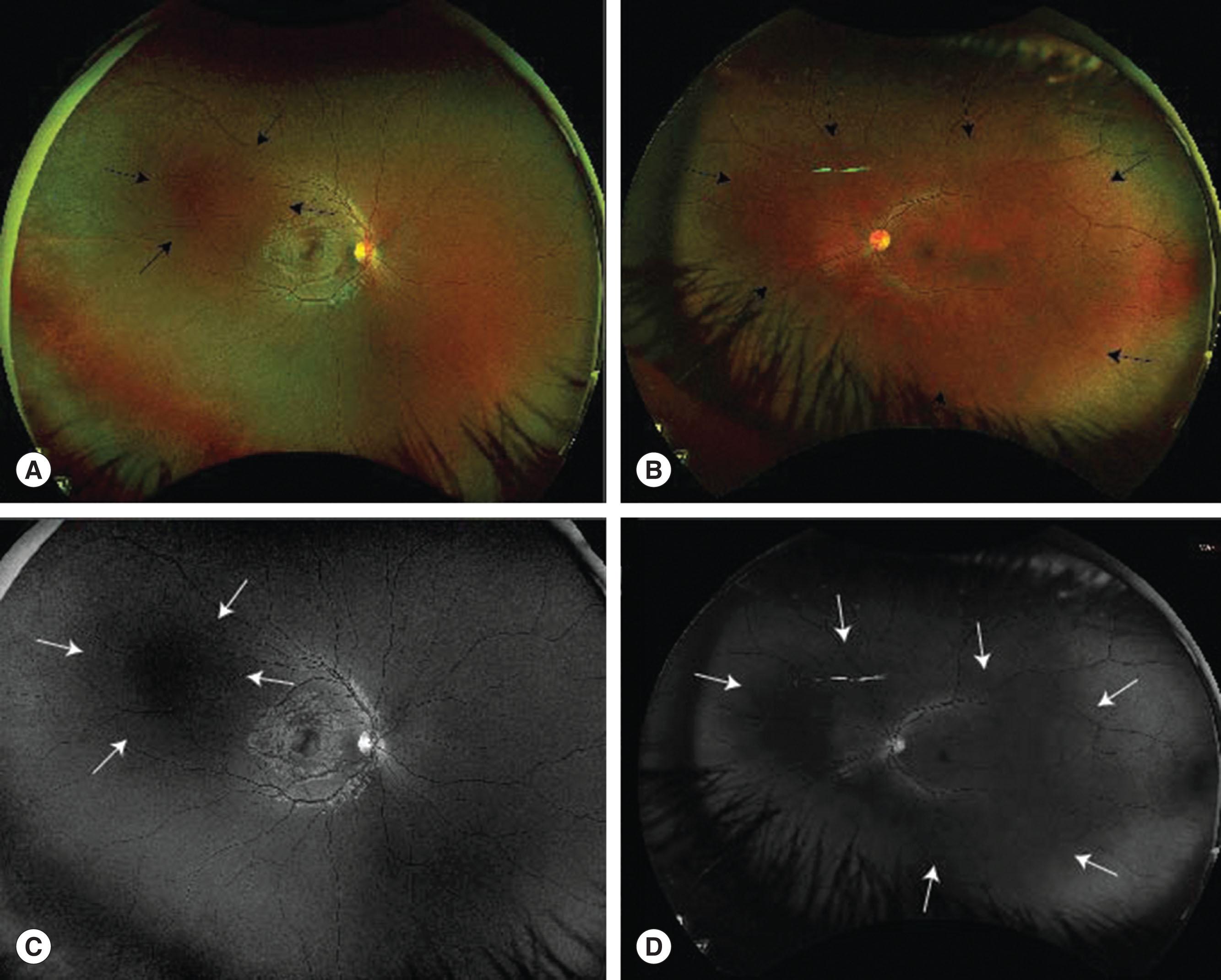
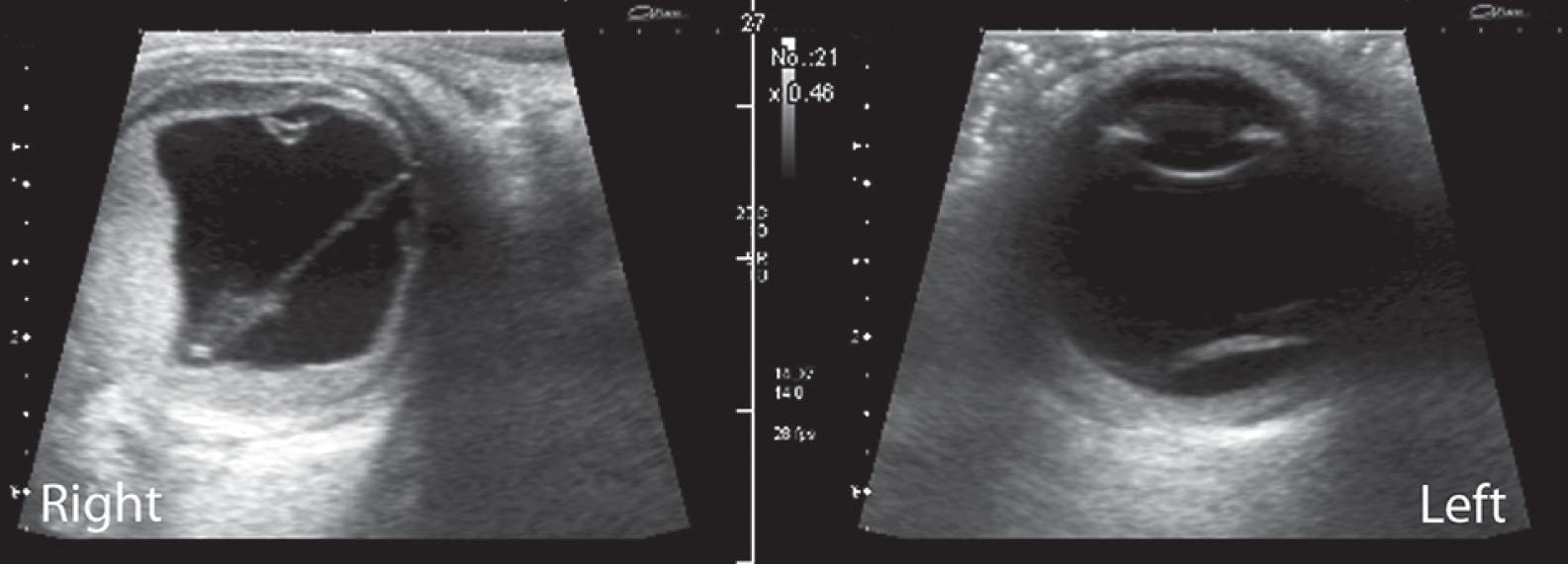
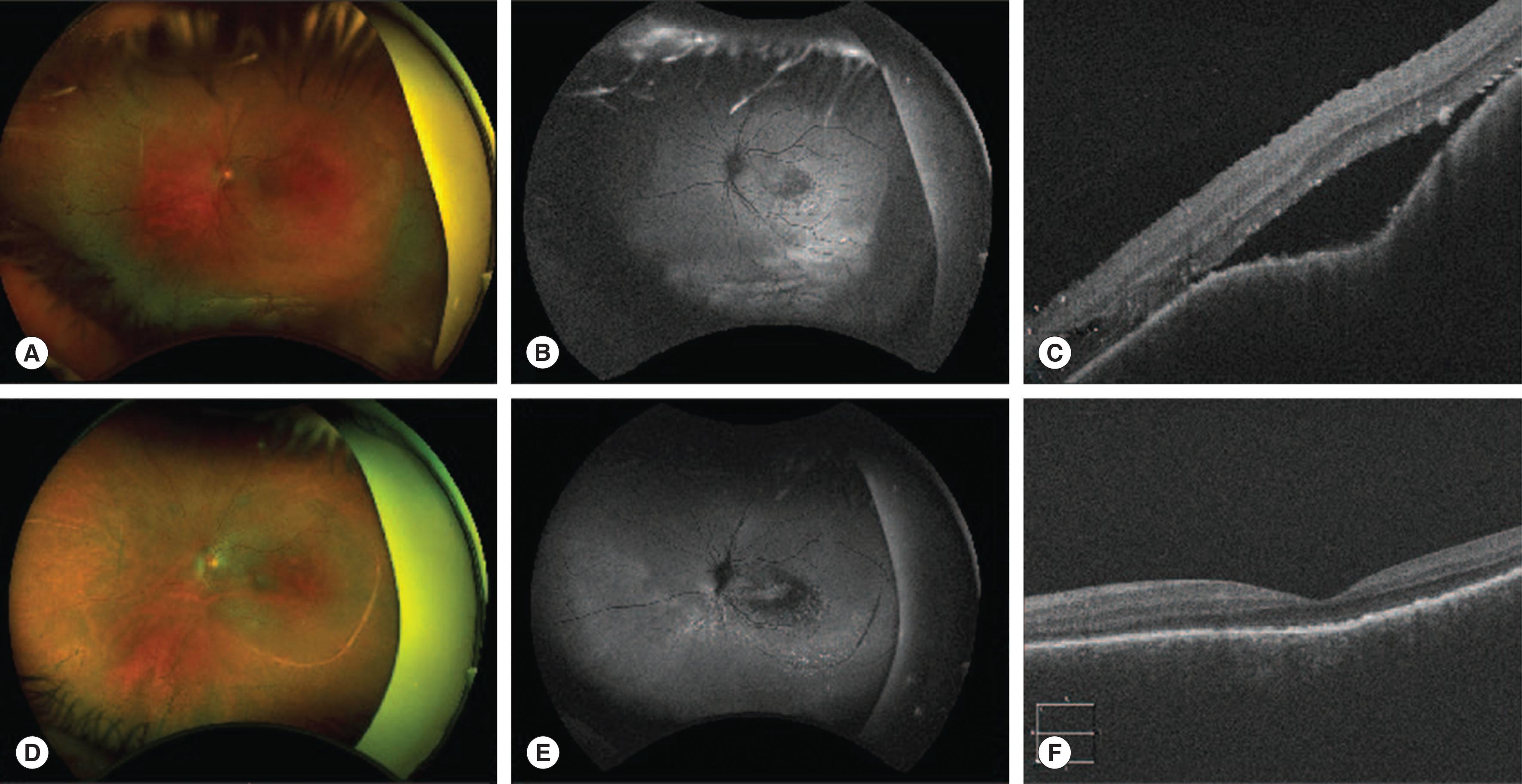
Glaucoma management is a challenge in SWS. Angle surgery is the procedure of choice in the early onset group. Antiglaucoma medications have an adjunctive role in this group. Medications are the initial management for the late onset group. Filtration surgery when required mandates alterations in technique to minimize hypotony and/or hemorrhage. For trabeculectomies this entails preplaced scleral flap sutures, either viscoelastic or an anterior chamber maintainer during the procedure. The risk of hemorrhage or effusion is proportional to the size of the choroidal vascular malformation. For tube implants surgical techniques are required to minimize intraoperative and late hypotony, including anterior chamber maintainer (25-G), and or viscoelastic at time of tube insertion, ligation of tube, and the use of a tube stent. Use of a small-gauge needle (25-G) for tube entry into the anterior chamber is advised. If intraoperative choroidal effusions occur (may be dramatic and rapid) then wound closure assisted by elevation of anterior chamber infusion bottle height ± drainage via preplaced sclerostomies is required.
Port wine stain is a capillary vascular malformation located in the papillary as well as superficial and reticular dermis. They are present at birth, often darken to a violaceous color, and become raised by middle age. Pulsed dye laser (PDL) is the standard treatment, and although complete resolution is rare, discoloration and underlying hypertrophy are reduced.
Table 68.1 provides recommendations for management of Sturge–Weber syndrome.
| Clinical issue | Recommendation |
|---|---|
|
|
|
|
| Stroke-like episodes |
|
| Headaches | Standard abortive and preventive agents |
| Glaucoma |
|
|
|
| Cognitive impairment |
|
| Psychosocial | Surveillance and early referral to support services |
| Endocrine | Monitor growth and thyroid function |
| ENT | Surveillance for ENT infections and obstructive sleep disorders |
| Other |
|
Tuberous sclerosis complex (TSC) is a multisystem disease characterized by hamartomatous growths that most commonly affect the brain, skin, kidneys, eyes, and heart but may affect almost any organ. Malignant tumors are rare and occur predominantly in the kidney. Incidence of TSC is estimated to be 1 in 6000.
Become a Clinical Tree membership for Full access and enjoy Unlimited articles
If you are a member. Log in here